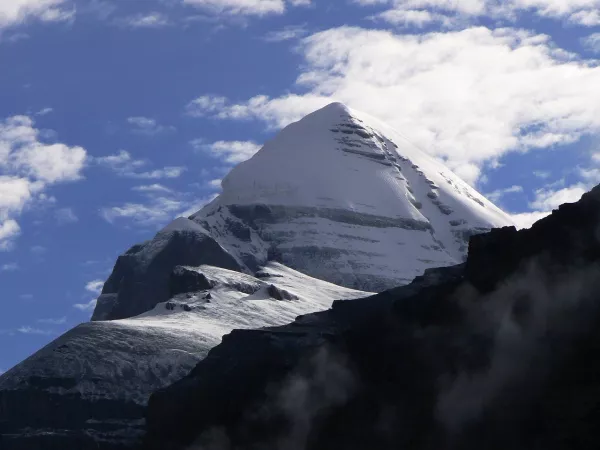
Kinnaur Kailash
Duration
4 to 7 Days
4 to 7 Days
Best time to visit
May-Jun, Sep-Oct
May-Jun, Sep-Oct
Theme
Hill Station, Adventure, Religious
Hill Station, Adventure, Religious
Kinnaur Kailash Travel Guide
Kinnaur Kailash, located in the Indian state of Himachal Pradesh, is a breathtaking destination known for its majestic mountains, serene valleys, and rich cultural heritage. This region is renowned for its spiritual significance as it is believed to be the abode of Lord Shiva. Kinnaur Kailash offers a perfect blend of natural beauty and religious importance, making it a popular destination among nature lovers and spiritual seekers alike.Top Attractions in Kinnaur Kailash
1. Kinnaur Kailash Parikrama Trek 2. Kamru Fort 3. Sangla Valley 4. Baspa River 5. Suicide PointKinnaur Kailash is Famous for
Its spiritual significance and stunning natural beauty.Top Attractions in Kinnaur Kailash
- Kinnaur Kailash Parikrama Trek - Kamru Fort - Sangla Valley - Baspa River - Suicide PointWhat's Great about Travelling to Kinnaur Kailash?
- Serene and picturesque landscapes - Rich cultural heritage - Ideal for spiritual seekers and nature loversWhat's Not So Great about Travelling to Kinnaur Kailash?
- Limited accommodation options - Remote location may not be suitable for all travelers - Harsh weather conditions in certain seasonsTravel Tips for Kinnaur Kailash
- Carry sufficient warm clothing and trekking gear - Respect the local customs and traditions - Acclimatize properly to avoid altitude sicknessImportant Kinnaur Kailash trip information
- Ideal Duration: A week to explore the major attractions
- Best Time to Visit: May to September for pleasant weather
- Nearby Airports and Railway Stations: The nearest airport is in Shimla and the closest railway station is in Chandigarh
FAQ's on Kinnaur Kailash
Q1: What is the best time to visit Kinnaur Kailash?
The best time to visit Kinnaur Kailash is during the summer months from April to June when the weather is pleasant for trekking and exploring the region. Another good time is during the autumn months of September to November when the skies are clear, offering stunning views of the mountains. Avoid visiting during the monsoon season from July to August due to heavy rainfall and landslides.
Q2: Do I need a visa to travel to Kinnaur Kailash?
Foreign tourists visiting Kinnaur Kailash will need a valid Indian visa. Make sure to check the specific visa requirements based on your nationality. Travelers from some countries may be eligible for an e-Visa or visa on arrival, but it's advisable to check with the Indian embassy or consulate before planning your trip.
Q3: What are the must-visit attractions in Kinnaur Kailash?
Kinnaur Kailash is known for its stunning natural beauty and spiritual significance. Must-visit attractions include the Kinnaur Kailash Mountain, Kalpa Village, Sangla Valley, Chitkul Village (the last inhabited village near the Indo-Tibetan border), and the ancient Kamru Fort. Don't miss the opportunity to explore the local temples and monasteries that reflect the rich cultural heritage of the region.
Q4: Is Kinnaur Kailash a safe place to travel?
Kinnaur Kailash is generally a safe destination for travelers. However, it's always recommended to take standard precautions like avoiding isolated areas at night and being mindful of your belongings. Some remote trekking routes may require a guide for safety. Stay informed about weather conditions and follow local advice while exploring the region.
Q5: What is the local currency in Kinnaur Kailash and can I use credit cards?
The local currency in Kinnaur Kailash is the Indian Rupee (INR). While credit cards may be accepted in some hotels and larger establishments, it's advisable to carry cash for smaller purchases and in remote areas. ATMs can be found in major towns like Reckong Peo and Sangla, but it's recommended to withdraw enough cash before heading to more rural areas.
Q6: What is the local cuisine like in Kinnaur Kailash?
offers a unique culinary experience with dishes influenced by Tibetan and Himachali cuisines. Try local specialties like Sidu (steamed bread), Thukpa (noodle soup), Momos (dumplings), and Chha Gosht (marinated lamb curry). Vegetarians can enjoy dishes like Lingri (fern) and Tudkiya Bhath (a type of rice). Don't miss out on trying the famous Kinnauri apple and apricot products.
Q7: What transportation options are available in Kinnaur Kailash?
Transportation options in Kinnaur Kailash include buses, shared taxis, and private cabs. The region is well-connected by road, but the mountainous terrain can make journeys longer. Public buses run between major towns, while shared taxis are a quicker option for shorter distances. Hiring a private cab or self-driving can offer more flexibility for exploring remote areas.
Q8: Are there any cultural norms or etiquette I should be aware of when visiting Kinnaur Kailash?
When visiting Kinnaur Kailash, it's important to respect the local customs and traditions. Modest clothing is recommended, especially when visiting religious sites. Always ask for permission before taking photographs of locals, and be mindful of the environment by avoiding littering. Greeting people with a "Juley" (hello) and showing respect for elders are appreciated gestures in the local culture.
Q9: I am a travel agent. How can I buy travel leads of Kinnaur Kailash?
Register yourself as a travel agent at agents.tripclap.com and then you can buy travel leads to Kinnaur Kailash once your account is approved. For more details contact our support team at +91-8069186564 or support@tripclap.com
